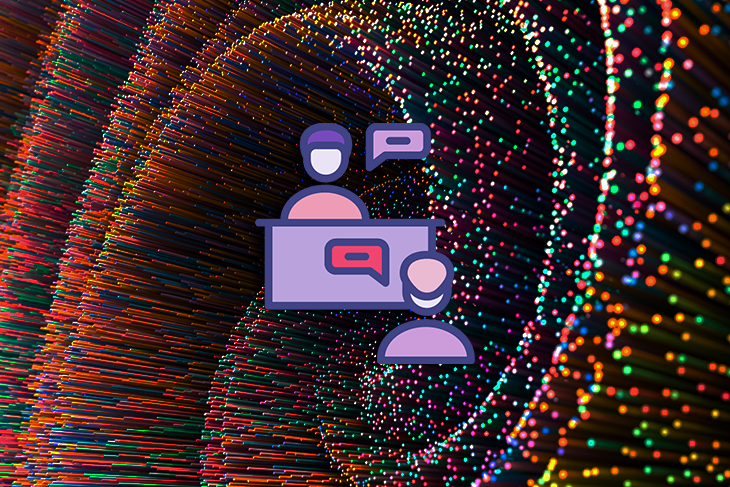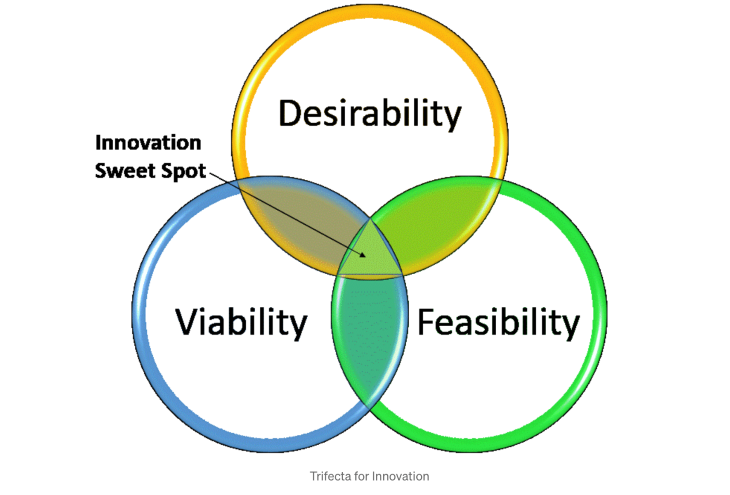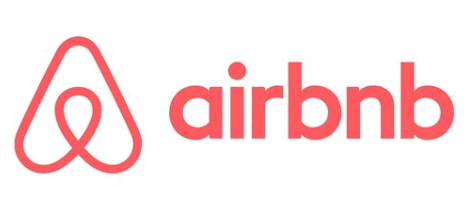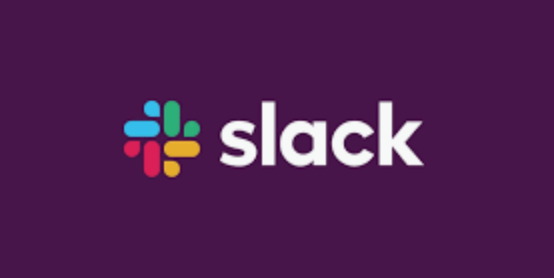Are you unsure how to balance desirability, feasibility, and viability in your designs? Perhaps you feel uncertain about which elements to prioritize or how to deal with conflicting factors. If that sounds like you, then you’re in the right place.

In this article, we’ll be diving into balancing desirability, feasibility, and viability in UX design, and how to manage and prioritize these different criteria when designing your own products. At the end, you’ll find a useful worksheet template to help you map out the desirability, feasibility, and viability of your projects.
Here’s what we’ll be covering:
Ready to learn more? Then let’s get started.
The desirability, feasibility, and viability framework is a design thinking approach used to test out hypotheses to see if a product has a unique value proposition that makes it worth exploring further. The idea behind the methodology is that if your product meets all three criteria, then it contains the elements needed to be successful. These elements are:
These elements provide a useful risk analysis checklist for new ideas; when all the criteria are met, a design team knows it has a concept worth taking forward. When some (or all) of the criteria are not met, it’s clear there are higher risks involved in the project and a higher chance of being unsuccessful.The methodology enables UX designers to identify areas of the design that need more work or more research, or helps a team come to the conclusion that an idea should be abandoned altogether.

Let’s take a look at the role of each element in the methodology before we run through how the three work together.
In design thinking, the concept of desirability is to assess whether the product or service the company is providing is considered essential to the user or merely a “nice to have.” As part of the assessment, a UX design team considers carefully how exactly the product assists users in reaching their goals and what success looks like to the user in a task-completion exercise.
By putting themselves in the position of the user, UX designers are able to empathize better with what the user is trying to achieve and more accurately identify the user’s major pain points when trying to reach a goal. If the product or service being tested solves these pain points, then it passes the desirability test. Put simply, the desirability test examines if the product is creating a solution for the right user problem.
When we talk about feasibility, we are referring to the creation of a product that a company has the technology, resources, and expertise to build. In addition, the timeframe for the product’s development and launch should be reasonable, taking into account the available employees who can work on it and any other projects being simultaneously managed.
A viable price point also comes into play here; the project should only go ahead if a price point that ensures value to the user and is affordable can be worked out. Other elements to take into account when it comes to feasibility include distribution, whether new hires are needed to take on the product’s development, and if the new product could support or promote the sale of any other products being sold by the company.
Viability is concerned with the solution’s business model and whether or not that model fits with users’ purchasing behavior and budget. The team’s goal is therefore to ensure that the product is financially viable in the short and long term and that it has both a sustainable and profitable trajectory.
Questions the UX team might ask themselves at this stage include: “Is the way we create this product profitable?” “Does the business model align with our customers’ current purchasing behavior?” “Is the product’s value chain viable and sustainable looking forward?” UX teams will need to be careful not to allow short term profit to be prioritized over long term sustainability.
When developing a product, UX designers seek to find a balance between desirability, viability, and feasibility in order to increase the likelihood of the product’s success. If a product is created or launched that fails to meet the criteria set in these areas, the risks for the business go up, as do the costs of developing it.
Teams should see these three areas as a lens through which a company can ensure their products and services for customers are desirable to those in their target user group, financially viable for the business, and technically feasible for the team and its resources.
As we’ve seen, desirability is concerned with how much users want a product and whether that product helps them to meet their needs or reach their goals. Using the framework of desirability, feasibility, and viability, a UX team begins by looking at desirability to see if a product idea will be a success with users. They do this by measuring a product’s impact using methods such as user research and persona creation, which offer valuable insights into users’ desires and goals.
Studying current industry trends and competitor products are also proven tactics for identifying and assessing desirability as they help the UX team understand changes in user behavior and responses to different products over time. Finally, customer journey maps — visual representations of users’ interactions with a brand and its products — help UX teams to understand user behavior, learn how desirable current offerings are, and identify what may currently be missing from their product range.
Other tools and methods for assessing desirability include:
Feasibility refers to whether it’s technically possible for your team to actually create the product you have in mind. To assess this, you’ll need to look closely at company resources, in-house expertise, budgets, tools, and what’s already planned for the quarter to get a sense of whether this is a product you can actually build and if now is the right time to build it.
In addition to your technical, financial, and human resources, it’s important to take legal and regulatory issues into account too as, depending on your product idea, these may turn a feasible project into an unfeasible (or much less feasible) one, fast.
Viability in product development is about whether a company has the budget to create and develop the initial idea and whether that idea is financially sustainable and ultimately profitable over the long term.
To measure this, a team should begin with a cost analysis that sets out all the associated costs of developing and launching the product, before developing a pricing strategy to determine the price of the product. The strategy should focus on market demand, competition, the cost of production, and the product’s perceived value.
Market research comes next. Market research enables a UX team to gain a better understanding of the target users and the size of the potential market. With the market research as its basis, sales forecasting usually follows. This involves estimating how many units the team expects to sell over a defined time period.
In addition to these main steps for testing a product’s financial viability, a team might also want to conduct a gross margin analysis and calculate the product’s return on investment (ROI). Finally, a risk assessment will help pinpoint any potential risks or uncertainties which could affect the product’s success and viability. From here, the team will have to assess how these risks might impact profitability and revenue.
Let’s take a look at two case studies that clearly demonstrate a balance of desirability, feasibility, and viability in their approach to their UX design.

Airbnb is a San Francisco-based company that operates a global marketplace for short and long term holiday accommodation and experiences.
The company created a website that was visually appealing and that provided a seamless user experience to both those providing accommodation (hosts) and those who wished to stay in the accommodation (guests). They did this through the implementation of a smooth and intuitive navigation system and by utilizing images of people and places that positively promoted the experiences of staying in a real home and experiencing different cultures.
An obstacle Airbnb faced early on was making sure those hosting the accommodation could both manage their online listings and coordinate with their guests while still preserving an intuitive, hassle-free booking process.
By introducing a powerful backend, Airbnb was able to address this problem; with the more robust system, hosts could better manage their accommodation listings while guests benefitted from new features such as instant booking — a gateway to a faster, more simplified booking experience.
Through the adoption of a peer-to-peer business model, Airbnb was able to scale at speed without actually owning any of the properties advertised on its platform. The company was instead able to create a sustainable revenue stream by taking commission from hosts and guests with each booking made.

Slack is an instant messaging and collaboration tool originally designed to assist with corporate and business communications. In recent years, numerous other communities have adopted the tool.
Slack was designed to be a delightful collaboration and communication tool. In order to create this, the design team focused heavily on user research and feedback, iterated on and honed design elements, and prioritized features and tools that optimized the user experience. Integration with other tools was a key part of Slack’s success, as was creating an interface that was enjoyable for users to interact with and the use of lighthearted but targeted messaging.
By continually improving the messaging app’s infrastructure over time, Slack could guarantee a reliable and fast communication platform for its users. It did this by focusing on what was technically feasible for the team through the regular assessment of its human and technical resources.
A freemium business model enabled Slack to become a fully viable company. This type of business model refers to a free plan that offers access to a range of additional features, meaning users can try out the product easily and without commitment. When teams need more advanced features, they can transfer to paid plans, in doing so generating a sustainable revenue stream for Slack.
Let’s take a look at the best ways to balance desirability, feasibility, and viability when designing and developing products and services as a team.
Communication within the UX team and within different teams at the company (development, marketing, business, and UX) is crucial to understanding and balancing conflicting factors when assessing the desirability, viability, and feasibility of a design or product. Every team member should be up to date on the latest user and market research, and team leaders should hold discussions so team members are both informed about and aligned on priorities.
If you’re a UX designer working for a client, you’ll want to ensure you have frequent check-ins, both to keep the client updated on your progress and to check you have all of the latest information from them regarding their users, new business developments, and any other complementary or conflicting projects in the pipeline.
As noted previously, user research is an important aspect of assessing a product’s desirability. This data informs potential solutions and enables the UX team to really understand their audience. While UX designers are designing for the end user primarily, if you’re working for different brands, then your client is also a member of the audience you are designing for.
For this reason, it’s always important to gather insights from project stakeholders (your clients) throughout the process via interviews, questionnaires, or user testing. Similarly, stakeholders and company employees will directly inform the design direction of a product as it is their skills, roles, resources, and responsibilities that the solution will need to be designed around. When taken into account, these aspects provide real parameters for feasibility and viability considerations, too.
At the start of a project, you’ll want to sit down with your team and write some well-defined goals to align team members, get stakeholders on board, and ensure that the most important elements of the project are achieved. Once you’ve come up with your list of goals, you’ll want to prioritize each in relation to how important they are to the project’s overall success.
When assessing the desirability, viability, and feasibility of your product design, you will need to closely evaluate trade-offs and be prepared to acknowledge that sometimes a compromise is a necessary part of moving the design forward. When evaluating trade-offs between the three sets of criteria, you’ll need to decide your next steps based on what best maintains a balance among the three and which is most preferable to the user.
An iterative design process will enable you and your team to make small, regular adjustments to your design in response to feedback from users, changes in business strategy, fluctuating markets, and any other project constraints or limitations. It is much easier for a team to maintain a balance between desirability, viability, and feasibility when the design process is flexible and in motion. A team that is ready to adapt as new information emerges is a team that can deal with complex design challenges as and when they arise.
A good rule of thumb when trying to balance conflicting priorities is to always put the user’s needs first, with the aim of meeting (or exceeding) their expectations. While the other criteria we’ve discussed in this article are important, if user needs get deprioritized for another factor, the project will almost certainly fail.
With desirability concerned with user needs and wants, viability concerned with finances, and feasibility concerned with implementation and resources, you’ll want to get expert input from many different team members as you develop your design in order to ensure you meet all the criteria for launching a successful product. These UX, business, and project management experts will be able to inform your decision-making process, suggest improvements or workarounds, and provide valuable insights about where companies can make trade-offs.
We hope you’ve enjoyed this run through of everything you need to know about balancing desirability, feasibility, and viability in UX design. You may want to learn more about how these constraints can actually help you size your project — Daniel Schwarz wrote an article on design constraints that can help you reframe your limitations.
LogRocket's Galileo AI watches sessions and understands user feedback for you, automating the most time-intensive parts of your job and giving you more time to focus on great design.
See how design choices, interactions, and issues affect your users — get a demo of LogRocket today.

Small actions can have large consequences in complex systems. Here’s how UX designers can manage dependencies so users feel informed and in control rather than blocked or blindsided.

This article examines when hero sections are necessary in digital products, when they create friction, and how to evaluate them using UX goals, primary actions, user flow impact, and real-world alternatives.

AI speeds up tasks like research synthesis, ideation, and first-draft wireframes, but it can’t replace clarity, taste, or decision-making. Here’s a grounded look at what AI actually does well in UX right now.

Discover how to craft UX-friendly hero sections with examples, design tips, and strategies that drive engagement and conversion.